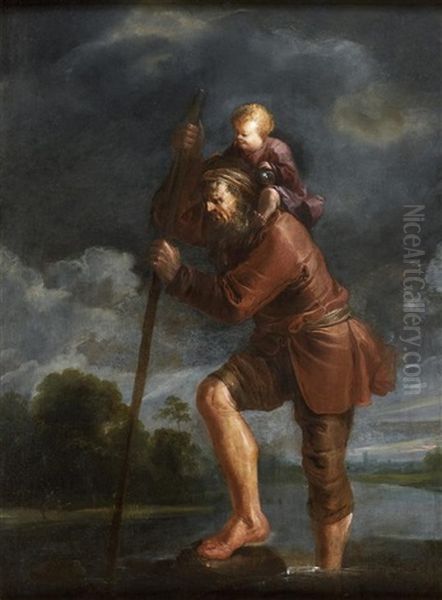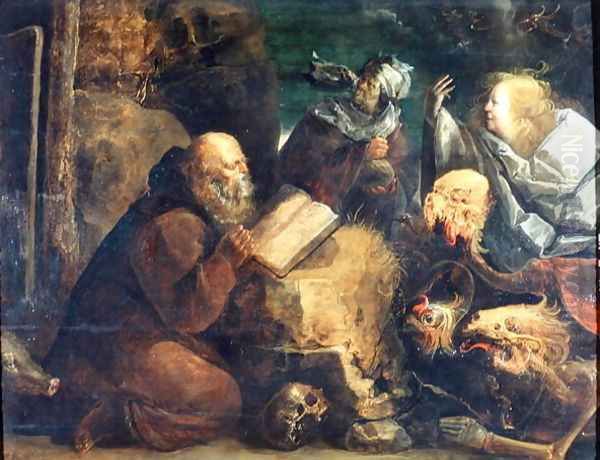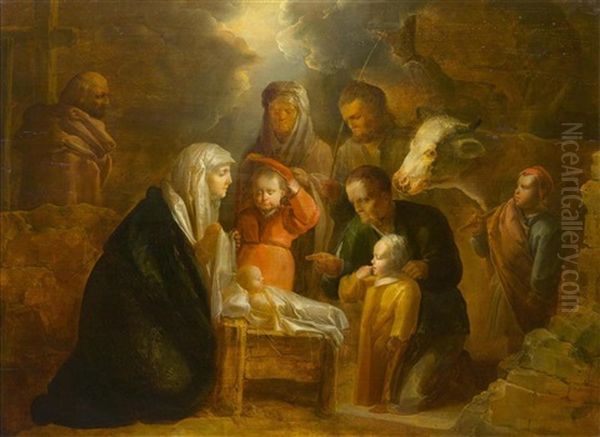Jan van de Venne, a notable yet sometimes overlooked figure of the Dutch Golden Age, carved a unique niche for himself with his distinctive style and thematic choices. Active during a period of extraordinary artistic flourishing in the Netherlands, Van de Venne's work stands out for its often humorous, satirical, and moralizing depictions of everyday life, alongside compelling religious scenes. His preference for grisaille, a monochrome palette, further distinguished his output, lending his compositions a sculptural quality and a focused intensity. Born around 1590 or 1592 in Mechelen, in the Southern Netherlands (now Belgium), and passing away around 1651, his career saw him active in several key artistic centers, including Brussels and later The Hague, where he became a respected member of the artistic community.
Early Life, Influences, and Artistic Formation
Jan van de Venne's artistic journey began in a region rich with artistic heritage. His birthplace, Mechelen, and his early activity in Brussels placed him in proximity to the enduring legacy of earlier Flemish masters. It is widely acknowledged that his work shows an affinity with the peasant scenes and satirical undertones found in the art of Pieter Bruegel the Elder. The vibrant, detailed, and often allegorical compositions of Jan Brueghel the Elder, another towering figure from this artistic lineage, also likely provided a source of inspiration, particularly in the meticulous rendering of figures and settings.
While concrete details about his earliest formal training are somewhat scarce, it is known that Jan was the brother of Adriaen Pietersz. van de Venne (c. 1589–1662), a more widely recognized painter, poet, illustrator, and publisher. This familial connection was undoubtedly significant. Adriaen himself had a diverse education, reportedly studying Latin in Leiden and receiving artistic instruction from the goldsmith and painter Simon de Valck in Leiden, and later from the grisaille specialist and printmaker Jeronimus van Diest in The Hague. It is highly probable that Jan benefited from his brother's artistic environment and connections, even if he did not formally apprentice under the same masters.

The provided information suggests that Jan van de Venne, much like his brother Adriaen, may have initially registered at Delft University but showed a greater inclination towards practical artistic learning. He is noted to have learned from local craftsmen, with Simon de Valck being mentioned as an instructor who influenced his painting, and Jeronimus van Diest for printmaking techniques, particularly grisaille. This practical, workshop-based learning, combined with self-study and observation of established masters, would have shaped his technical skills and artistic vision. His early works, therefore, likely reflect a blend of these influences, rooted in the Flemish tradition but evolving towards his own distinct approach.
Relocation and Establishment in The Hague
At a certain point in his career, Jan van de Venne moved from the Southern Netherlands to the Dutch Republic, eventually settling in The Hague. This city was a significant political and cultural center, boasting a thriving artistic scene. In 1625, Jan van de Venne took a crucial step in establishing his professional standing by joining the Guild of St. Luke in The Hague. The guilds were powerful institutions that regulated the art trade, set standards for craftsmanship, and provided a network for artists. Membership was essential for any artist wishing to practice and sell their work independently.
His involvement with the Guild of St. Luke was not merely nominal. By 1636 or 1637, Jan van de Venne had risen to the esteemed position of dean of the guild. This role would have involved administrative responsibilities, upholding the guild's statutes, and representing the interests of its members. Achieving such a position speaks to his reputation and respect among his peers in The Hague. It indicates that he was not only a practicing artist but also a recognized figure within the city's artistic community.
The Hague provided a fertile ground for artists like Van de Venne. The presence of the court of the Princes of Orange, government officials, and a wealthy citizenry created demand for various types of art. While Jan van de Venne is not primarily known as a court painter, the vibrant artistic milieu and the diverse patronage opportunities in The Hague would have supported his career, allowing him to develop his characteristic themes and styles. His activities in The Hague extended beyond painting; he was also involved in book illustration and print design, further showcasing his versatility.
Artistic Style: Grisaille and Thematic Focus

Jan van de Venne's artistic style is particularly notable for his frequent use of grisaille. This technique, which involves painting in shades of a single color, typically grey or brown, creates a monochromatic effect. By limiting the palette, grisaille emphasizes form, light, and shadow, often lending a sculptural or relief-like quality to the artwork. For Van de Venne, this technique served to heighten the expressiveness of his figures and the narrative impact of his scenes. It allowed him to focus on the characterization and the underlying message of his work without the potential distraction of vibrant colors.
His thematic concerns were diverse, ranging from religious subjects to scenes of everyday life, often with a satirical or moralizing edge. In his genre paintings, Van de Venne frequently depicted "low-life" subjects: peasants, beggars, card players, itinerant musicians, charlatan tooth-pullers, and gypsies. These portrayals were not merely observational; they often carried an element of social commentary or humor. His depictions of gypsies were so characteristic that he earned the French nickname "Le maître des Tziganes" (The Master of the Gypsies). These works tap into a long tradition in Netherlandish art, seen in the works of Hieronymus Bosch and Pieter Bruegel the Elder, which explored the foibles and realities of human existence, often through the lens of the common folk.
The satirical element in Van de Venne's work is significant. By portraying figures like fools, thieves, or boisterous peasants, he could subtly critique societal norms, human vices, or contemporary behaviors. This approach resonated with a broader cultural trend in the Dutch Golden Age, where art often served an didactic or moralizing purpose, encouraging viewers to reflect on virtue and vice. Artists like Adriaen Brouwer, Adriaen van Ostade, and Jan Steen also excelled in genre scenes that combined humor with social observation, though each had their distinct style. Van de Venne's use of grisaille in these contexts could lend a particular starkness or directness to his commentary.
Religious Works and Narrative Power
Alongside his genre scenes, Jan van de Venne also produced compelling religious paintings. Works such as "Saint Christopher" and "The Martyrdom of Saints" are cited as representative examples of his output in this domain. In these pieces, his ability to convey narrative and emotion would have been paramount. The grisaille technique, when applied to religious subjects, could create a sense of solemnity, drama, or spiritual intensity. The focus on light and shadow inherent in monochrome painting can be particularly effective in highlighting the suffering of martyrs or the spiritual resolve of saints.

The tradition of religious painting in the Netherlands was complex, especially after the Reformation. While the Calvinist Dutch Republic officially discouraged religious imagery in churches, there was still a private market for biblical scenes and depictions of saints, particularly among Catholic patrons or those with more tolerant views. Artists continued to explore these themes, drawing on established iconographies while also innovating in their interpretations. Van de Venne's religious works would have contributed to this ongoing tradition, offering his unique stylistic interpretation of sacred narratives.
His skill in depicting expressive figures, honed in his genre scenes, would have translated well to religious subjects. The ability to capture a range of human emotions – piety, suffering, devotion, or malevolence – was crucial for effective religious storytelling. While fewer specific details about a large corpus of his religious works are provided in the initial summary, their mention underscores his versatility and his engagement with the major artistic themes of his time.
Collaborations, Illustrations, and Broader Ventures
Jan van de Venne's artistic activities were not confined to easel painting. He was actively involved in book illustration, a field where his brother Adriaen was particularly prolific. A significant collaborative project involved providing illustrations for "Houwelyck" (Marriage), a highly popular and influential moralizing work by the renowned Dutch poet and statesman Jacob Cats. Such emblem books and moral treatises were widely read in the 17th century, and illustrations played a key role in conveying their messages to a broad audience. The collaboration between Jan and Adriaen on projects like this highlights the close working relationship between the brothers and their shared engagement with the cultural and literary trends of their era.
The source material also indicates that Jan van de Venne, at one point, possibly in Middelburg before his Hague period, operated a publishing company and engaged in art dealing. If this refers to Jan and not a conflation with his brother Adriaen (who was indeed a publisher and art dealer), it would paint a picture of an artist with significant entrepreneurial acumen. A publishing house owned by an artist could become a hub for creative exchange, attracting poets, writers, and fellow artists, as suggested by the mention of his company and garden becoming a gathering place. This multifaceted engagement with the art world – as a creator, a facilitator through publishing, and a trader – would have given him a comprehensive understanding of the artistic ecosystem.
The mention of political satire, such as the painting "Fishing for Souls" (1614), is intriguing. This specific work is famously attributed to Adriaen Pietersz. van de Venne and is a complex allegory of the religious strife between Catholics and Protestants. If Jan was involved in this or similar works, it would underscore his engagement with the pressing political and religious issues of his day. Satirical prints and paintings were potent tools for commentary and propaganda during this period, and artists often played a role in shaping public opinion. The collaborative nature of many print and publishing ventures means that distinguishing individual contributions can sometimes be challenging.
Contemporaries and the Artistic Milieu
Jan van de Venne operated within a vibrant and competitive artistic landscape. The Dutch Golden Age saw an unprecedented production of art, with numerous painters specializing in various genres. His direct influences, as mentioned, include Pieter Bruegel the Elder and Jan Brueghel the Elder, whose works set a precedent for genre and landscape painting. His teachers, Simon de Valck and Jeronimus van Diest, provided him with foundational skills in painting and printmaking.
His brother, Adriaen Pietersz. van de Venne, was a constant presence and collaborator, a versatile artist in his own right. In the realm of genre painting, particularly scenes of peasant life and taverns, artists like Adriaen Brouwer and Adriaen van Ostade were prominent contemporaries, known for their lively and often boisterous depictions. Jan Steen, slightly younger, also became famous for his humorous and moralizing genre scenes, filled with anecdotal detail. While their styles differed, they shared an interest in capturing the everyday life and social customs of the period.
In the Southern Netherlands, where Van de Venne began his career, David Teniers the Younger was a leading figure in genre painting, particularly known for his kermesses and peasant interiors. The cross-pollination of ideas between the Southern and Northern Netherlands was ongoing, despite political divisions.
The broader artistic context of The Hague would have included painters specializing in various fields. For instance, portraitists like Michiel Jansz. van Mierevelt were highly successful in The Hague. While not a direct influence on Van de Venne's known work, the presence of such diverse talents contributed to the richness of the artistic environment. Even major figures like Rembrandt van Rijn in Amsterdam or Johannes Vermeer in Delft, while operating in different cities and often with different primary focuses, were part of this larger explosion of artistic creativity that characterized the Dutch Golden Age. Frans Hals in Haarlem, with his dynamic portraits, also exemplifies the era's innovative spirit. The intellectual climate, fueled by writers like Jacob Cats, also provided rich material for artists engaged in moralizing or emblematic imagery.
Legacy and Rediscovery
Jan van de Venne's works were reportedly popular during his lifetime. His distinctive style, particularly his grisaille paintings and his focus on often humorous or satirical genre scenes, found an appreciative audience. His depictions of society's lower strata, while sometimes comical, also offered a glimpse into the diverse fabric of 17th-century life and contributed to the rich tradition of Dutch genre painting. This genre, with its focus on everyday reality, had a profound impact on the course of Western art.
However, over time, the identities and oeuvres of artists can sometimes become obscured or confused, especially when they share a surname or work in close collaboration. The source material notes that Jan van de Venne's artistic identity was, for a period, mistakenly conflated with that of his more famous brother, Adriaen. This is not uncommon in art history, particularly for artists who were perhaps less prolific or whose works were not consistently signed.
A significant moment in the reassessment of Jan van de Venne's work came in 1978, when Jacques Foucart, a curator at the Louvre Museum in Paris, helped to clarify his distinct artistic personality and correct previous misattributions. Such scholarly interventions are crucial for rescuing artists from obscurity and ensuring their contributions are properly recognized. This rediscovery allows for a more nuanced understanding of his oeuvre and his place within the Dutch Golden Age.
The enduring appeal of his art, particularly his genre scenes, lies in their lively characterizations and their often-humorous take on human nature. His grisaille technique remains a distinctive feature, showcasing his skill in composition and his ability to create impactful images through a limited palette. His influence on later genre painting, while perhaps not as direct or widely acknowledged as that of some of his contemporaries, is part of the broader legacy of Dutch Golden Age art, which continued to inspire artists for centuries.
Conclusion: A Distinctive Voice in a Golden Era
Jan van de Venne emerges as a fascinating and multifaceted artist of the Dutch Golden Age. From his early exposure to the rich artistic traditions of Flanders to his established career in The Hague as a painter and guild dean, he navigated the vibrant art world of the 17th century with skill and a distinctive vision. His preference for grisaille set him apart, allowing him to explore form and narrative with focused intensity.
His thematic range, encompassing lively and satirical genre scenes of peasants, gypsies, and everyday characters, as well as more solemn religious subjects, demonstrates his versatility. The collaborations with his brother Adriaen, particularly in book illustration for prominent authors like Jacob Cats, highlight his engagement with the broader cultural and intellectual currents of his time. Potential ventures into publishing and art dealing further suggest an artist with a keen understanding of the art market and a proactive approach to his career.
While perhaps overshadowed at times by more famous contemporaries or even his own brother, Jan van de Venne's contribution to Dutch art is undeniable. His works offer a unique window into the society of his time, rendered with humor, insight, and a distinctive artistic signature. The ongoing process of art historical research, exemplified by the work of scholars like Jacques Foucart, continues to shed light on such artists, ensuring that their individual voices are heard and their contributions to the rich tapestry of the Dutch Golden Age are fully appreciated. Jan van de Venne remains a testament to the diversity and dynamism of one of art history's most celebrated periods.